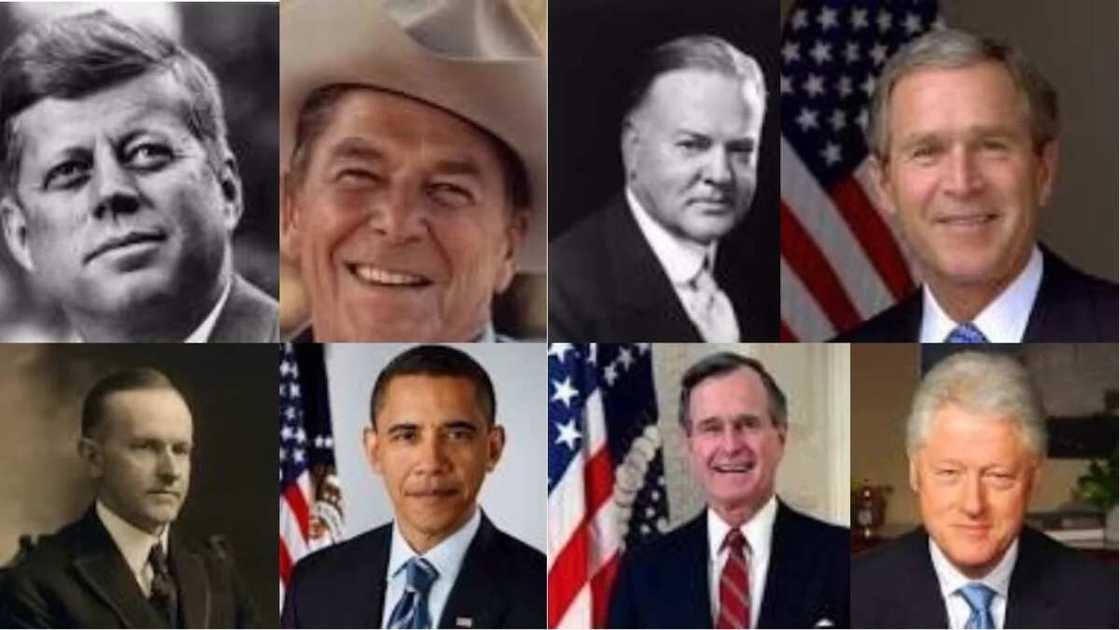15 past US presidents and their foreign policies
In this report, Legit.ng brings you a list of the last 15 past presidents of the United States of America and their policies as it relates to the affairs of the world.
1. Calvin Coolidge
1923-1929
Coolidge’s foreign policy involved ignoring the Soviet Union. His government also supported the Mexican government in spite of the rebels and lifted the ban on the country to use arms.
His initiative in terms of foreign policy was the Kellogg-Briand Pact that renounced war as the instrument for solving disputes between nations. But this pact eventually failed there was no body to enforce the Pact on the international community.
2. Herbert Hoover
1929-1933
President Hoover's foreign policies were remembered for four great landmarks which are: Blame game, giving peace a chance, being a good neighbor and having a humanitarian heart.
The reported that the president was unable to control the ever-worsening depression that gripped America, hence, he blamed the situation in part on the European economic instability brought on by World War I.
READ ALSO: What Nigerians In America Do To Regularize Residency
In 1929, many countries entered a global treaty renouncing war but Japan violated this treaty by invading Manchuria in 1931, Hoover advised against sending American troops to repel the invasion.

Another of his foreign policy was the ending of the US occupation of Nicaragua and, in 1932, entered a treaty with Haiti that promised a full withdrawal of S troops within three years.
3. Franklin D. Roosevelt
1933-1945
The United States emerged as one of the great powers on the globe after the end of 1918 war. Roosevelt who is staunch supporter for remaining isolated from any crisis in Europe began his presidency with the hopes of increasing trade with the world while staying out of any conflict but when Adolf Hitler invaded Poland in 1939, France and Britain declared war. Though Americans wanted no part in the war, Roosevelt began to alter his isolationist posture as German forces conquered most of Europe. While remaining neutral, the United States began sending supplies to Britain and, later, the Soviet Union.
4. Harry S. Truman
1945-1953
After World War II, the countries of Eastern Europe found themselves under the occupation and influence of the Soviet Union. Most of these countries became communist satellite or ''puppet'' states of the Soviet Union.
The spread of communism throughout Eastern Europe was alarming to the U.S. and its allies. President Harry Truman believed it had to be stopped. In 1947, he delivered a famous speech in which he announced what came to be known as the Truman Doctrine.
The Truman Doctrine marked the official implementation of the American foreign policy of containment. Containment policy meant that the U.S. would act to contain, or quarantine, the spread of communism, but not act to combat it where it already existed. Containment policy served as the backbone of American foreign policy during much of the Cold War.
5. Dwight D. Eisenhower
1953-1961
During his presidency, Eisenhower managed Cold War-era tensions with the Soviet Union under the looming threat of nuclear weapons, ended the war in Korea in 1953 and authorized a number of covert anti-communist operations by the CIA around the world.
6. John F. Kennedy
1961-1963
The foreign policy of the John F. Kennedy administration in 1961–1963 saw diplomatic and military initiatives in Europe, Southeast Asia, Latin America and other regions amid considerable Cold War tensions. Kennedy deployed a new generation of foreign policy experts, dubbed "the best and the brightest".
7. Lyndon B. Johnson
1963-1969
The major initiative in the Lyndon Johnson presidency was the Vietnam War. By 1968, the United States had 548,000 troops in Vietnam and had already lost 30,000 Americans there.
8. Richard M. Nixon
1969-1974
President Nixon pursued two important policies that both culminated in 1972. In February he visited Beijing, setting in motion normalization of relations with the People's Republic of China. In May, he traveled to the Soviet Union and signed agreements that contained the results of the first Strategic Arms Limitation Treaty talks (SALT I), and new negotiations were begun to extend further arms control and disarmament measures.
9. Gerald R. Ford
1974-1977
Ford's main accomplishment was probably the signing of the Helsinki Agreement in 1975. This agreement continued the policy of detente that had been started by President Nixon. In it, the US agreed to recognize the legitimacy of the Soviet Union and its control over Eastern Europe.
10. James Carter
1977-1981
The election of Democrat Jimmy Carter as President in 1976 brought a new emphasis, based on Carter’s personal ideology, to U.S. foreign policy. Carter believed that the nation’s foreign policy should reflect its highest moral principles—a definite break with the policy and practices of the Nixon Administration.
Carter refused to continue the past practice of overlooking the human rights abuses of our own allies, and was particularly tough on South Korea, Iran, Argentina, South Africa, and Rhodesia (Zimbabwe). He also ended more than 30 years of U.S. political and military support to one of Latin America’s most abusive leaders—President Somoza of Nicaragua.
11. Ronald Reagan
1981-1989
When Reagan became President he had only one well-defined foreign policy goal: containing the Soviet Union, or the "evil empire" as he once referred to it. He primarily wanted to stop the USSR from growing larger and to keep other non-Communist countries from becoming Communist.
He disliked the decade-long Detente begun by President Nixon and continued by President Ford intended to ease relations with the Soviets. Reagan firmly believed that the USSR was using Détente and the SALT talks to take advantage of the United States.
12. George H. W. Bush
1989-1993
George H.W. Bush entered office with one of the most impressive resumes of any president, having served as director of the Central Intelligence Agency, ambassador to the United Nations and Ronald Reagan’s vice president.
He left office with an impressive list of achievements, including managing the peaceful collapse of the Soviet Union and the unification of Germany. But a major high point of his presidency was also the harbinger of disappointments to come: the swift military victory that reversed Saddam Hussein’s invasion of Kuwait and seemed to herald a new era in world affairs – but left Saddam Hussein in power.
13. William J. Clinton
1993-2001
Clinton focused on the creation of a new approach to international affairs, a policy his advisers called the "doctrine of enlargement." This doctrine, based on the idea of expanding the community of market democracies around the world, embraced free trade, multilateral peacekeeping efforts and international alliances, and a commitment to intervene in world crisis situations when practical and morally defensible.
The policy promoted an activist role for America and was designed to extend and protect basic human and civil rights insofar as it was within the power of the United States to successfully achieve those goals without undermining national security or depleting national resources.
14. George W. Bush
2001-2009
The Bush Doctrine refers to various related foreign policy principles of President George W. Bush. These principles include unilateralism and the use of preventative war.
This policy principle was applied particularly in the Middle East to counter international terrorist organizations and to justify the invasion of Iraq.
PAY ATTENTION: Read the news on Nigeria’s #1 new app
15. Barack Obama
2009-2017
Obama's foreign policy include renewed troop surge in Afghanistan, the negotiation of the New START nuclear arms reduction treaty with Russia, the NATO intervention in Libya, the withdrawal from Iraq, ongoing trade negotiations with China, and of course, the killing of al Qaeda leader Osama bin Laden.
Buhari 2019 posters have flooded the streets; too early - on Legit.ng TV
Source: Legit.ng


